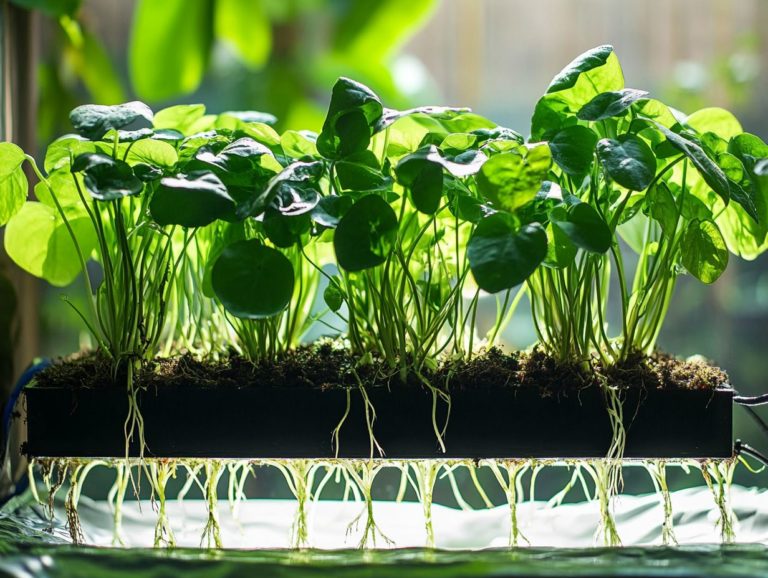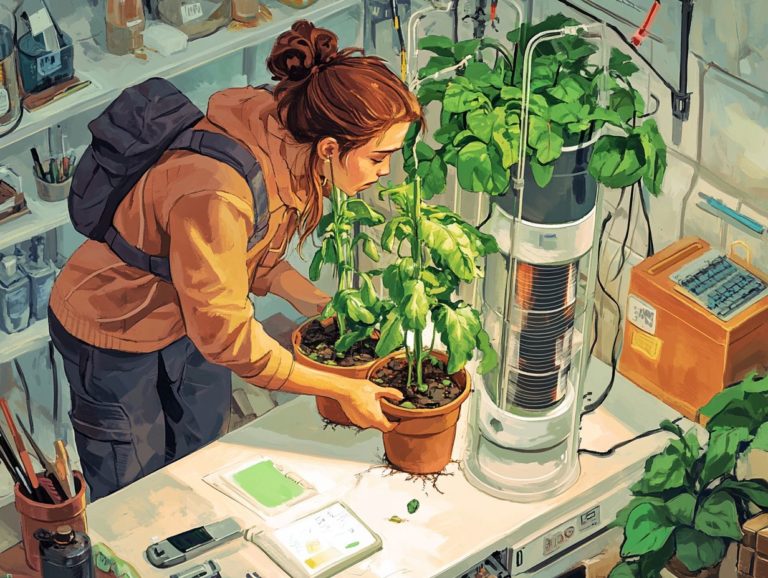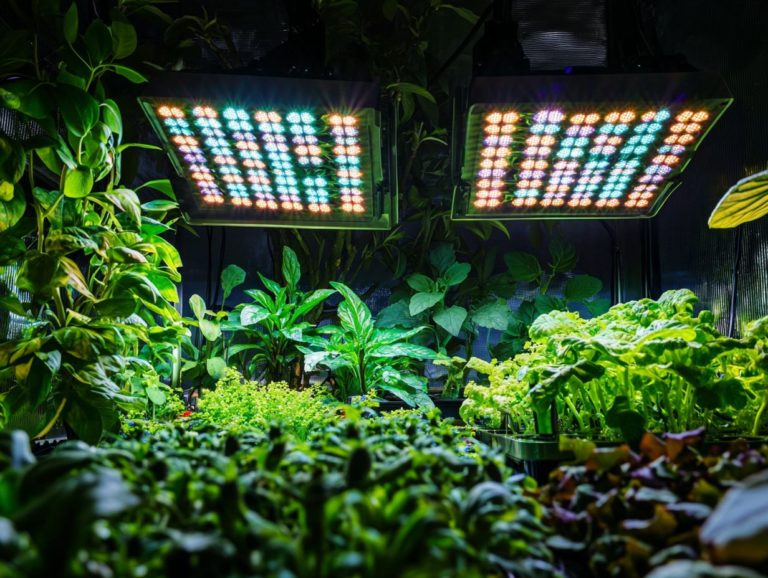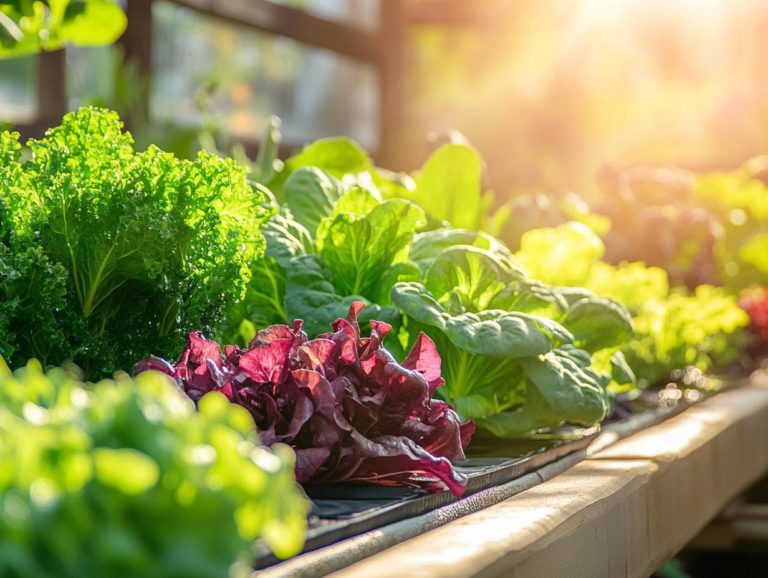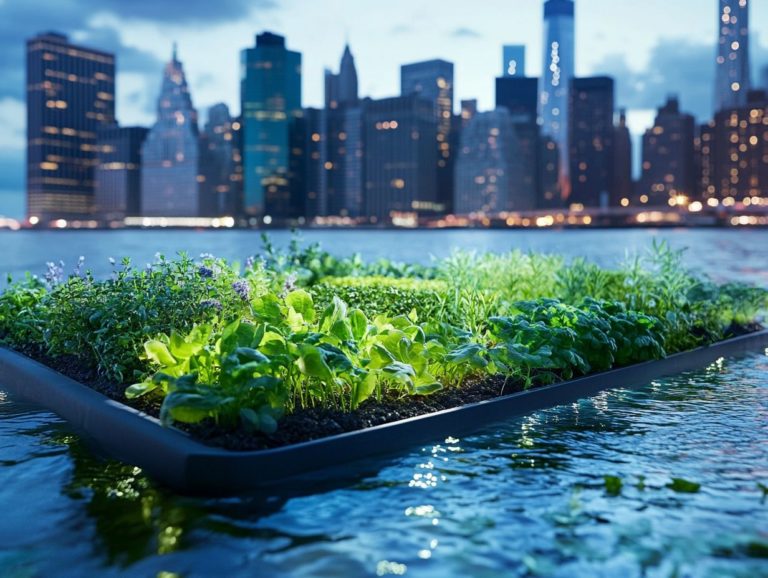What are the Best Vegetables for Hydroponic Gardening?
Discover how hydroponics can revolutionize your gardening! Hydroponics is transforming the landscape of food cultivation, providing a sustainable and efficient alternative to traditional soil-based methods that you won t want to overlook.
In this article, you ll uncover many benefits of hydroponics and how it stands out against conventional gardening practices. Learn how to select the best vegetables for your hydroponic setup, along with valuable growing tips and essential pitfalls to sidestep.
You will also find a complete guide to the essential equipment required to embark on this journey. Whether you re an experienced gardener or just dipping your toes into this fascinating world, this guide equips you with everything necessary to cultivate delicious vegetables hydroponically, including tomatoes, cucumbers, and peppers.
Contents
- Key Takeaways:
- Benefits of Growing Vegetables Hydroponically
- Advantages over Traditional Gardening
- Choosing the Right Vegetables for Hydroponic Gardening
- Factors to Consider
- Top Vegetables for Hydroponic Gardening
- Common Mistakes to Avoid in Hydroponic Gardening
- Getting Started with Hydroponic Gardening
- Frequently Asked Questions
- Curious about the best vegetables for hydroponic gardening?
- Can I grow root vegetables in a hydroponic garden?
- Do I need special equipment for hydroponic gardening?
- Can I grow a variety of vegetables together in one hydroponic system?
- Are there any vegetables that are not suitable for hydroponic gardening?
- How do I know which nutrients to use for my hydroponic vegetables?
Key Takeaways:
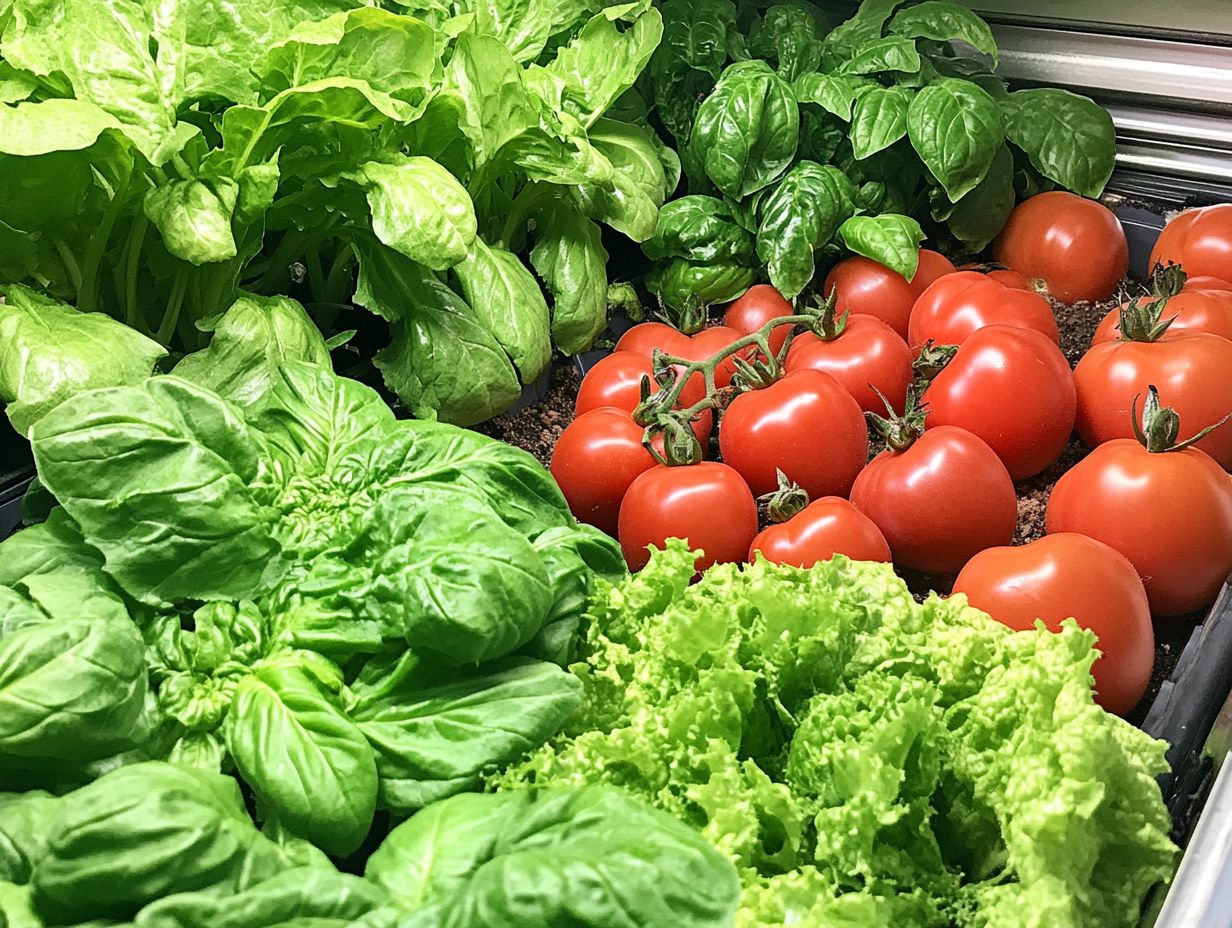
- Hydroponic gardening is a method of growing plants in a water-based solution mixed with essential nutrients, without soil.
- Hydroponic gardening offers higher yields, faster growth, and uses less water and space than traditional gardening.
- When choosing vegetables for hydroponic gardening, factors such as light, temperature, and root space should be considered.
What is Hydroponic Gardening?
Hydroponic gardening is a groundbreaking method for growing plants without soil, using water mixed with essential nutrients instead. This innovative approach transforms the way you can cultivate various plants, from leafy greens to vibrant vegetables, all within controlled hydroponic systems that can seamlessly integrate into modern smart gardens.
By grasping the principles of this technique, you can maximize both yield and efficiency, enabling year-round production of crops like tomatoes, cucumbers, and peppers. This ultimately paves the way for greater self-sufficiency and sustainability in your gardening endeavors.
Originating from ancient civilizations, hydroponics has undergone significant evolution over the centuries. Today, you have a range of systems to explore, including methods like Ebb and Flow, Deep Water Culture, and Nutrient Film Technique:
- Ebb and Flow: a method that periodically floods the plant roots with nutrient solution before draining it away.
- Deep Water Culture: where roots dangle in a bath of nutrient-rich water.
- Nutrient Film Technique: allowing a thin film of nutrient solution to flow over the roots.
Each of these methods presents unique advantages that can be tailored to meet your specific indoor gardening needs, making hydroponics an exceptionally versatile solution for urban farmers eager to enhance their green thumb, even in limited spaces.
Benefits of Growing Vegetables Hydroponically
Growing vegetables hydroponically presents a wealth of advantages over traditional gardening methods, making it an appealing option for both novice and seasoned gardeners alike.
By embracing hydroponic systems like nutrient film and deep water culture, you gain the ability to cultivate the finest vegetables year-round. These systems allow for meticulous control over growing conditions, which include factors like light and temperature, ensuring that each plant thrives and delivers exceptional flavor.
With automatic watering systems in place, you can significantly lighten your workload, freeing you up to fully immerse yourself in your hydroponic adventure. This means you can relish the delights of fresh produce, including crisp lettuce, vibrant spinach, and aromatic herbs, all at your fingertips.
Advantages over Traditional Gardening
Hydroponics offers a range of compelling advantages over traditional gardening, particularly when it comes to resource efficiency and crop yield. Unlike soil-based gardening, water-based gardening systems dramatically reduce pest pressures and soil-related diseases, allowing you to nurture healthier plants with superior nutrient absorption.
This method also extends your growing season, giving you the freedom to cultivate a diverse array of vegetables including tomatoes, peppers, and even strawberries regardless of outdoor climate conditions.
Research shows that water-based gardening systems can produce crops up to three times faster than conventional farming practices. They also use up to 90% less water, primarily through the system that recycles water to nourish plants, making them a sustainable choice for areas with limited water supplies.
Hydroponics also requires less space. With vertical farming techniques, you can stack multiple layers of plants in a compact area, maximizing land use effectively.
For urban dwellers, this means you can effortlessly grow your own fresh produce on balconies or rooftops, enhancing food security while also reducing the carbon footprint associated with transporting goods.
Choosing the Right Vegetables for Hydroponic Gardening
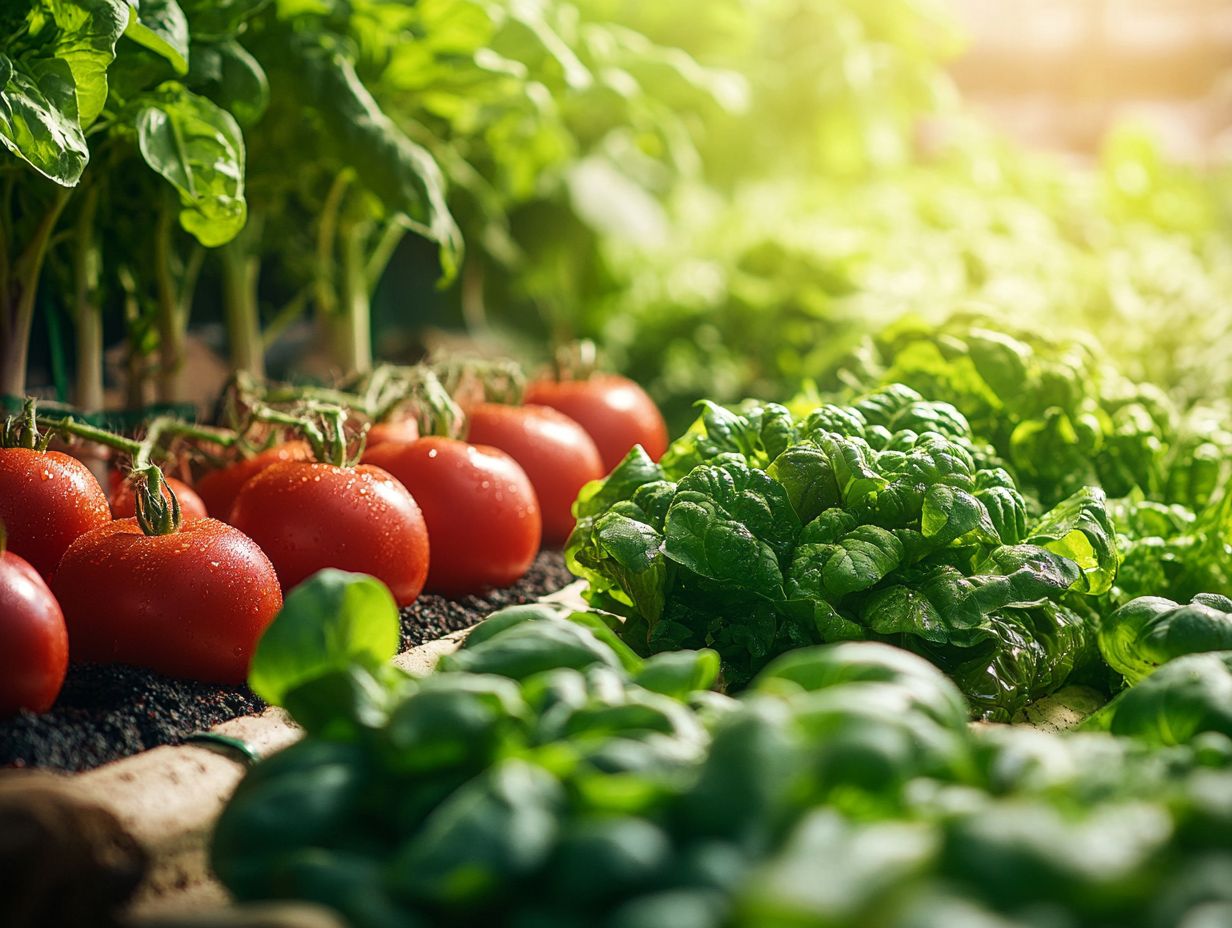
Selecting the right vegetables for your hydroponic garden is crucial for maximizing yield and ensuring a gratifying harvest. As you choose your plants, take into account factors such as growing conditions, available space, and the specific hydroponic system you re employing.
The finest vegetables for hydroponic setups typically feature compact plants like leafy greens and herbs, alongside larger varieties such as tomatoes and cucumbers. These plants thrive in optimized hydroponic environments, making them a perfect choice for both newcomers and experienced gardeners alike.
Factors to Consider
When selecting vegetables for hydroponic gardening, consider several key factors to ensure your indoor farming success. Understanding the specific growing conditions like light requirements and nutrient needs is crucial, as these can vary significantly among different plants.
For larger vegetables like tomatoes and cucumbers, you should set up support systems to help them grow. In contrast, compact plants such as green onions and leafy greens thrive beautifully with less space and care in optimized hydroponic setups.
For instance, leafy greens typically prefer temperatures between 60 and 70 degrees Fahrenheit. On the other hand, fruiting vegetables like peppers and eggplants are more suited to warmer environments, around 70-80 F.
Maintaining appropriate humidity levels, usually between 40-60%, is vital to prevent mold and promote healthy growth. You ll also need to tailor your nutrient solutions: tomatoes crave higher levels of phosphorus during their flowering stages, while lettuce flourishes on a balanced nutrient profile.
Lastly, effective lighting is essential. Whether you re relying on natural sunlight or artificial sources, calibrating the lighting to meet each plant s specific intensity and duration needs ensures they all get the light they need to grow strong.
Top Vegetables for Hydroponic Gardening
You ll find a delightful array of vegetables that thrive in hydroponic gardening, each bringing its own unique benefits and flavors to the table.
Leafy greens like lettuce, spinach, and kale are among the top contenders, known for their rapid growth and minimal space requirements. But don t overlook the sturdier options; vegetables like tomatoes, cucumbers, and peppers can flourish in hydroponic systems when given the right conditions and care.
Imagine enjoying a bounty of fresh produce straight from your garden, no matter the season. Start your hydroponic garden today and enjoy fresh veggies year-round!
Recommended Varieties and Tips for Success
Selecting the right varieties of vegetables is essential for your hydroponic gardening success. Specific strains are tailored for this soil-less environment.
For instance, you might want to grow heirloom tomatoes, celebrated for their rich flavors and ability to thrive indoors all year long. Varieties like Brandywine and Cherokee Purple are particularly noteworthy for their sweetness and striking colors.
Leafy greens such as arugula and bok choy also flourish in hydroponic systems. Arugula, with its peppery flavor and rapid growth, is perfect for consecutive harvests.
Herbs like basil and cilantro are excellent choices as well. Opt for Genovese basil, known for its aromatic leaves and consistent productivity.
The slow-bolting variety of cilantro guarantees a longer harvest period. Each of these selections not only elevates your culinary creations but also adds vibrancy and productivity to your hydroponic garden.
Common Mistakes to Avoid in Hydroponic Gardening
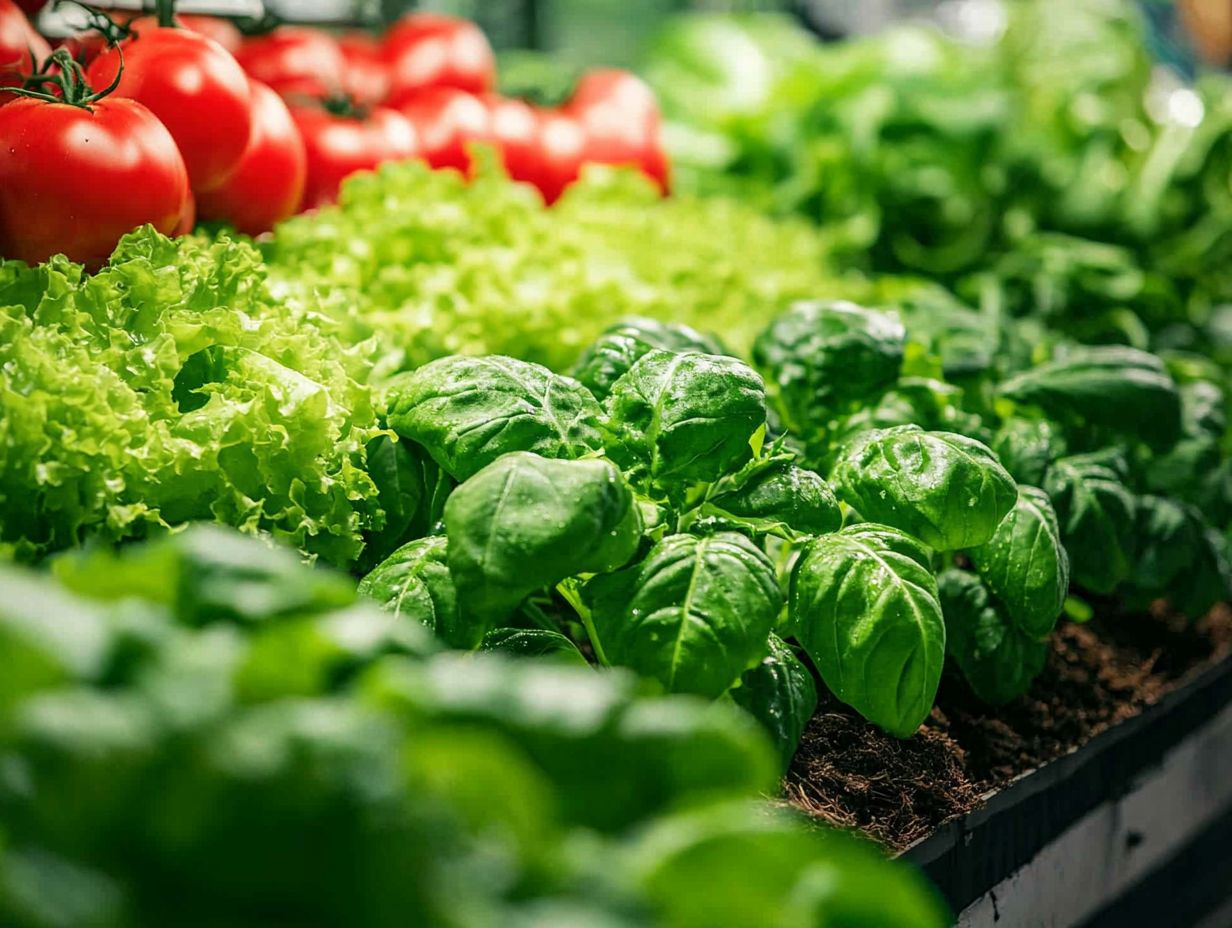
Hydroponic gardening is a fun and rewarding adventure! It s crucial to be aware of common mistakes that could impede your hydroponic journey.
One frequent pitfall is neglecting proper nutrient management, which can lead to imbalances that adversely affect plant health. Not closely monitoring environmental conditions can lead to subpar growth and make your plants more vulnerable to pests.
This highlights the significance of careful planning and management within your hydroponic system.
How to Prevent and Address Issues
Preventing and addressing issues in hydroponic gardening demands your diligence and a proactive mindset. Regularly monitoring nutrient levels and fine-tuning formulations can stave off nutrient deficiencies that may stunt growth.
Implementing effective pest management strategies, such as introducing beneficial insects or utilizing organic treatments, is vital. This allows your plants to truly flourish.
Maintaining optimal pH levels is essential. Even minor fluctuations can lead to nutrient lockout, preventing your plants from absorbing the vital elements necessary for robust development.
Routine checks and calibrations of water quality act as your shield against harmful pathogens. Employing proper drainage systems can thwart root rot and promote healthy aeration.
Conducting regular inspections for signs of mold or algae helps you nip potential problems in the bud before they escalate. Cultivating a systematic approach to identify signs of nutrient overload or deficiencies enables you to make swift adjustments.
Getting Started with Hydroponic Gardening
To embark on your hydroponic gardening journey, it’s crucial to grasp the essential equipment and setup needed. You’ll want to familiarize yourself with key components like plant trays, which can be adapted to different hydroponic systems such as Ebb and Flow or Deep Water Culture.
Automatic watering systems are invaluable, making nutrient delivery a breeze. By investing in high-quality equipment and mastering the basics of hydroponic gardening, you can start a fulfilling adventure in growing your own vegetables and herbs indoors.
Dive into the world of hydroponics today and enjoy fresh veggies at your fingertips!
Essential Equipment and Set-up
To successfully establish your hydroponic garden, you ll need a selection of essential equipment tailored to your specific gardening goals. Consider hydroponic systems like Nutrient Film Technique (NFT), Ebb and Flow, and Deep Water Culture; each offers unique advantages based on your available space and the crops you wish to cultivate.
Smart garden technologies elevate your gardening experience by automating processes such as watering and nutrient delivery. This ultimately optimizes plant health and maximizes yield.
Investing in quality lighting solutions, like LED grow lights, is crucial. These lights provide the necessary spectrum for photosynthesis, especially in indoor setups.
A reliable pH and nutrient monitoring system is equally vital, ensuring your plants receive the perfect balance of elements for optimal growth.
Be sure to include essential tools like:
- Growing trays
- Air pumps
- Net pots
Each of these contributes significantly to a flourishing hydroponic environment. Don t overlook the importance of a sturdy reservoir for holding nutrient solutions, along with a water pump to maintain proper circulation. Every piece of equipment plays a pivotal role in crafting a successful hydroponic ecosystem.
Frequently Asked Questions
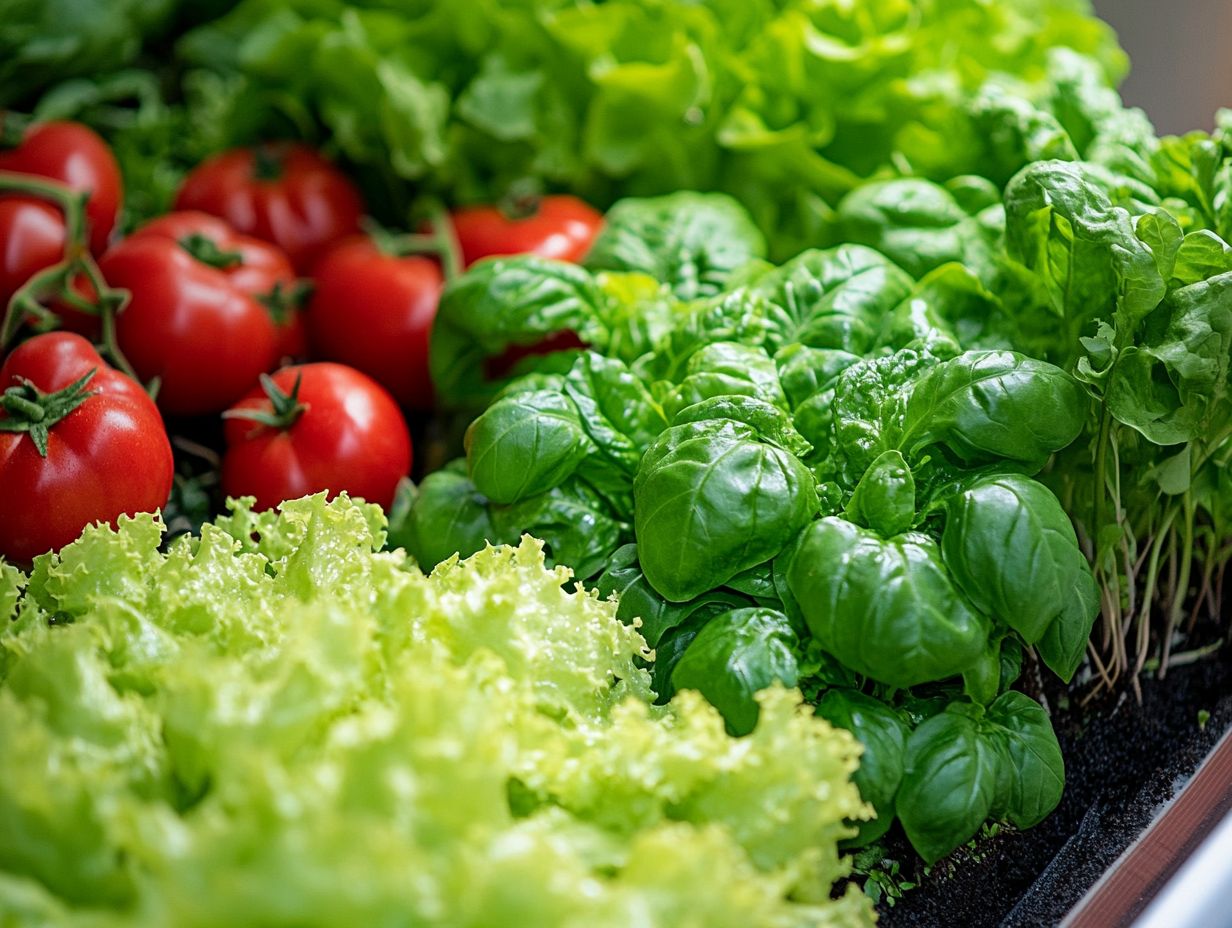
Curious about the best vegetables for hydroponic gardening?
There are several great options, including lettuce, tomatoes, cucumbers, peppers, and herbs like basil and mint.
Can I grow root vegetables in a hydroponic garden?
While some root vegetables can be grown in hydroponic systems, they typically require more space. It’s best to stick with shallow-rooted plants for hydroponic gardening.
Do I need special equipment for hydroponic gardening?
Yes, you will need basic equipment such as a hydroponic system, grow lights, and nutrients. However, many hydroponic gardening kits are available that include all the necessary equipment.
Can I grow a variety of vegetables together in one hydroponic system?
Yes! As long as the plants have similar nutrient and environmental requirements, they can thrive together in a hydroponic garden. This allows for diverse and efficient use of space.
Are there any vegetables that are not suitable for hydroponic gardening?
Some vegetables, such as corn and carrots, are not well-suited for hydroponic gardening due to their deep root systems. It’s best to focus on shallow-rooted plants.
How do I know which nutrients to use for my hydroponic vegetables?
Each plant has specific nutrient requirements, so it’s important to research the needs of the vegetables you are growing. You can also purchase pre-made nutrient solutions tailored for different types of plants.

